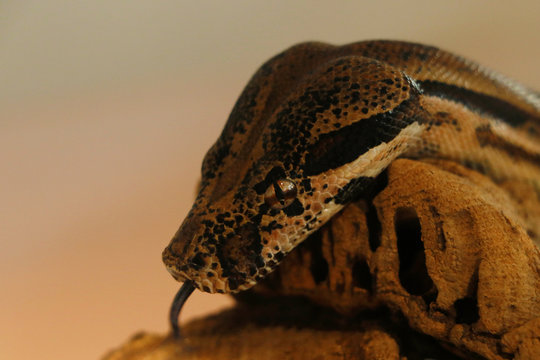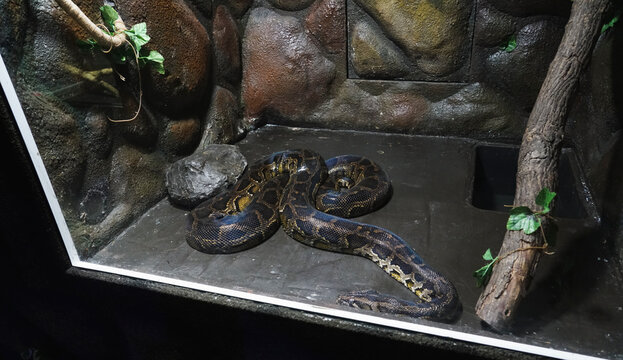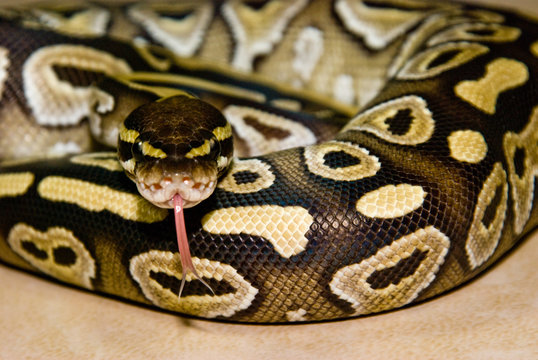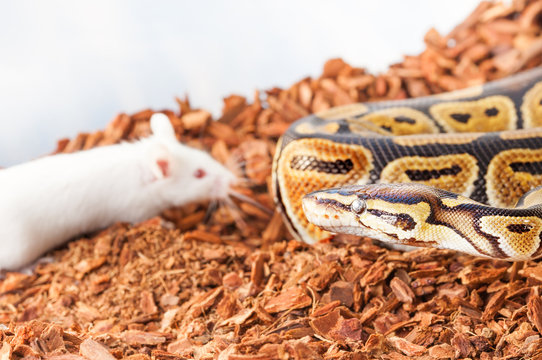Among the many choices for pets, ball pythons are fantastic to keep around especially for snake enthusiasts.
They are not difficult to care for and are easy to keep clean. They do, however, have food requirements that differ significantly from those of a cat or dog.
In this article, you, as a new ball python owner, will learn about the right food to feed your pet, the frequency and the solution if it refuses to take in the food.
This article has been reviewed by Dr. Gospel. Read more about our knowledge control process here.
Contents
How Do You Know When A Ball Python Is Hungry?

It can be difficult to know when a ball python is hungry. If you do get this incorrectly, the food within your pet’s container will decay and go to waste.
In contrast, if your ball python does not receive the nourishment it requires at the appropriate time, it may become unwell. So, how can you know whether your pet is hungry and ready to eat?
When a ball python is hungry, it will prowl the front of the tank, become more active, fixate on you anytime you get close to the cage, and flick its tongue more frequently.
Prowling Their Enclosure

Your ball python will spend more time moving along the front of the enclosure. This might be due to hunting behavior or being conditioned to attempt to catch your attention. It may be asking you to feed it.
If your pet has just eaten its meal, prowling their enclosure could be their attempt to get away and avoid any stress they might have encountered inside.
A caution here is that ball pythons, like humans, tend to flee. They are anxious and seeking a way out of their tank at this point.
Moving In And Out of Hides Regularly
There should be lots of hiding spots in the enclosure of your ball python.
Ball pythons enjoy their solitude, and they are most at ease if they have someplace to go to when they are digesting food or need to sleep.
If your ball python enters and exits hides frequently without staying within, your pet may be hunting for food, especially if your pet hunts in burrows naturally.
Also read: Do Ball Pythons Burrow? 04 Reasons why Ball Pythons Burrow
Air Tasting And Flick Their Forked Tongues More Often

Ball pythons smell their surroundings by means of flicking their forked tongues in and out of their mouths.
When they do this action, particles in the air are collected and are routed to their vomeronasal organs. These organs help them use their sense of smell.
This is a solid indicator that your ball python is on the lookout for food and attempting to figure out where it is in its surroundings.
If your pet flicks its forked tongue more than usual, it indicates hunger.
Also read: Why Do Ball Pythons Hiss? Handling a Defensive Ball Pythons
Soaking And Resting Less Than Usual
A ball python that is more active than normal is either on the hunt or attempting to avoid stress.
If your pet enjoys soaking in water but is doing it less frequently, it may be an indication that it needs to be fed.
Immersion can help a ball python digest its food, so it’s much more inclined to do so after it has eaten.
Also read: Do Ball Pythons Like Water? You Didn’t Know This
Terrarium Water Bowl
- Reptile Feeding Bowl Durable Resin Feeding Plate Rock Shape Food Water Feeding Dish for Lizard Gecko Tortoise
- Natural looking water dish for any terrarium environment
- Durable and stable; Not easily tipped over
- Features Smooth Interior Surface and Inwardly Curved Walls, the Worms Make Difficult To Escape.
- worm dish is suitable for geckos, snakes, lizards, spiders, centipedes, chameleons, corn snakes, iguanas and other reptiles.
Last update on 2022-12-29 / Affiliate links / Images from Amazon Product Advertising API
Staring At You More Than Usual
Ball pythons associate food with you. If your pet appears to be significantly more interested in you than normal, it is a good indicator they desire a pleasant reward from you.
Your Feeding Schedule
Normally, ball pythons are fed every 1–2 weeks, and it usually depends on their maturity and type.
If it is about time to feed your ball python, they will do so because it has become accustomed to this routine.
Ball pythons are nocturnal or crepuscular by nature but you’ll see hunting or prowling activity when it is time to eat. It is highly important to keep a regular feeding schedule.
Also read: Ball Python Feeding Chart: Feeding made easy!
How often Should You Feed Your Ball Python?

Your pet doesn’t require to be fed daily. The young ones only need to eat twice a week while the older ones need feeding for only once or twice a week.
To begin, you must realize that most ball pythons will feed when they are both pleased and hungry.
They aren’t machines, and unlike mammals, they don’t always eat when they’re hungry. All ball pythons, especially ball pythons, frequently fast and go without food by simply pausing to eat for a while.
Your veterinarian may provide you with more detailed feeding instructions based on your pet’s unique needs.
When you present food and your pet eats, it means he is hungry and needs nourishment. If he does not eat right away, he is not hungry and probably does not need to be fed right now.
Ball pythons should be taught to devour the carcasses of their prey. They can be fed either thawed or newly killed prey that has been previously frozen.
Most pet stores will provide you with freshly killed or frozen rats to feed, so you won’t have to kill the prey yourself.
How Long Can Your Ball Python Go Without Eating?
Ball pythons have generally simple dietary needs. Even if you can go many days without eating, you do not want to go too long without eating.
An adult ball python may go for up to six months without feeding, although this can be dangerous to the reptile’s health. This ability helps during drought and egg incubation.
Some, on the other hand, have been known to last without meals for even longer periods.
They may live up to eight months in certain situations, and in extreme cases, they can last for nearly a year without eating.
Ball pythons in the wild are frequently forced to go without food for lengthy periods owing to food scarcity.
Their bodies’ low energy demands and capacity to store and maintain calories make them well suited to food scarcity in the wild.
Despite having a consistent food source, captive ball pythons can go anywhere from 2 to 7 months without eating.
Baby ball pythons may also refuse to feed for some time, although this is usually only safe for about a month.
Also read: How Long Can A Ball Python Go Without Eating?: The TRUTH!
What Can You Feed Your Ball Python?
Ball pythons, like other snakes, devour a variety of prey sizes depending on their size.
Snakes that are smaller and younger can consume giant insects, but they should eat small and soft ones until they become larger.
Mature ball pythons eat adult mice and rats. They can also eat unprocessed human foods such as eggs, chicken, fish, pig, and beef.
This implies that the meal should be served in its most basic and raw state.
Also read: What Do Ball Pythons Eat? The complete List
Zoo Med Repti Cave for Reptiles
- This product is easy to use
- This product adds a great Value
- This product is Manufactured in United States
Last update on 2022-12-29 / Affiliate links / Images from Amazon Product Advertising API
Conclusion
Hope you have found this material useful and that you can use it to determine whether your ball python is hungry.
Remember to consult your veterinarian if you have any significant problems so that your snake can return to being joyful and healthy.


